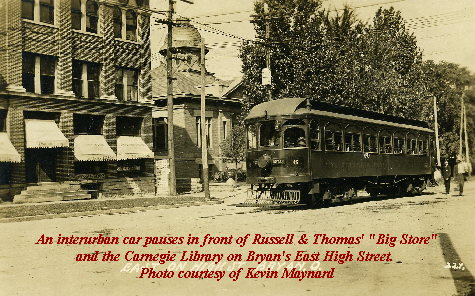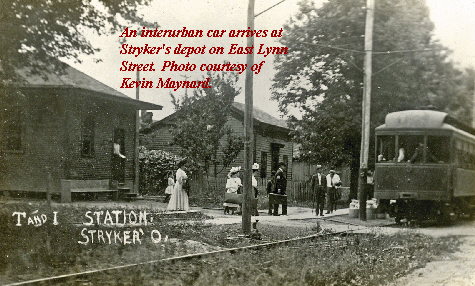|
The first run of the T & I Railroad
by Howard L. Carvin as published in The Bryan Times, May 4, 1955
Thursday, June 1, 1905, was the beginning of a new era for the citizens of Bryan, and about noon on that day, people formed along East High Street and waited anxiously, heads turned toward the eastern edge of the village. At 12:30, their anxiety was transformed into cheers and it was a happy, jostling crowd that followed the first Toledo and Indiana electric car up High Street to the depot, located at the present site of the A. & P. Store [at the southwest corner of High and Walnut streets].
The handsome, new coach left Toledo at 10:30 and made the 54-mile trip over the recently completed road in two hours. The initial trip was not a passenger run, but railroad officials and men from the construction company made up the first load into Bryan. J. M. Longnecker, president of the Toledo and Indiana Railroad Company, and D. H. Lavenburg, general manager of the line, were aboard. Patrick Hirsch, president of the Hirsch Construction Company, which built the road, also had the honor of riding the first car from Toledo to Bryan. A banquet was held at the Christman Hotel, and all who attended were guests of the railroad.
The T. and I. was one of the best electric roads in the state. Gravel and stone was used for the roadbed and the finest 70-pound rails made the runway for the cars.
The power plant for the entire railroad was located at Stryker, and the machinery was capable of supplying enough power for 116 miles of road. The extra heavy equipment would have been needed if future plans of the company had materialized. Shortly after completing the line to Bryan, surveyors were busy looking over the territory between Bryan and Fort Wayne. Company officials predicted the line would be extended by March 1st, 1906, and the title was to be Toledo, Fort Wayne and Western.
Extension Plans Fail
Original plans for the extension called for three routes to be surveyed—the first through Hicksville, the second passing through Butler, Auburn and Garrett, and the third through Butler, Waterloo, Auburn and Garrett. The route through Hicksville was shorter by 10 miles than the other two proposed routes; however, the latter could have furnished 15,000 more patrons.
The second car arrived in Bryan on Friday evening, June 2nd, 1905, and the Toledo and Indiana electric railroad was in business.
 The cars, like the roadbed itself, were the finest money could buy. They were equipped with 75-horsepower motors and were capable of a top speed of 65 miles per hour. One of the more famous business slogans of the T. and I. was “no smoke, cinders or dust,” and these were just a few of the things that made the electric road a favorite means of transportation. The cars, like the roadbed itself, were the finest money could buy. They were equipped with 75-horsepower motors and were capable of a top speed of 65 miles per hour. One of the more famous business slogans of the T. and I. was “no smoke, cinders or dust,” and these were just a few of the things that made the electric road a favorite means of transportation.
The daily schedule of the road fit perfectly with the patrons’ plans. The first car each day left Bryan at 5:45 a.m. and another car left each hour after that until the final one at 9:45 in the evening. All cars arrived at Bryan at 15 minutes after the even hour, and a stay of 30 minutes allowed passengers time to shop and return to any point east on the same car. One of the first round trip prices from Bryan to Toledo was $1.55, cheap transportation even in those days before the automobile was a common sight.
Abandoned in 1939
The Toledo and Indiana electric railroad served the communities between Bryan and Toledo faithfully and well until one bleak fall day in 1939. Competition had been keen, freight had been moving by train and truck, the passenger cars were no longer few, but there was one for nearly every family.
The business of the electric road had been falling off considerably over a period of years and it was finally decided to discontinue operations.
At a few minutes after 9 o’clock on Sunday evening, October 15, 1939, 35 veteran employees of the T. and I. boarded car number 100 at the station in Toledo to make the last run. L. W. Vernier of Stryker, the oldest motorman in point of service, had the honor of operating the last car over the road. Other employees from Bryan making the farewell trip were Barney Gavin and Clyde Garver.
Car number 100 arrived in Bryan at 11:10 p.m. The sight was a completely different one than that of 34 years and a few months previous. There was no crowd on hand to meet the final car and no banquet held after the arrival. The men debarked quietly from the car, there were a few tearful handshakes, and each went their way.
The Toledo and Indiana electric railroad, which in 1904 was only a dream, had come, done a thriving business and gone. Once again, it was only a reality in the minds of the people it served so well.
---appeared in the Summer 2007 Bean Creek Chronicle
|


 The cars, like the roadbed itself, were the finest money could buy. They were equipped with 75-horsepower motors and were capable of a top speed of 65 miles per hour. One of the more famous business slogans of the T. and I. was “no smoke, cinders or dust,” and these were just a few of the things that made the electric road a favorite means of transportation.
The cars, like the roadbed itself, were the finest money could buy. They were equipped with 75-horsepower motors and were capable of a top speed of 65 miles per hour. One of the more famous business slogans of the T. and I. was “no smoke, cinders or dust,” and these were just a few of the things that made the electric road a favorite means of transportation.